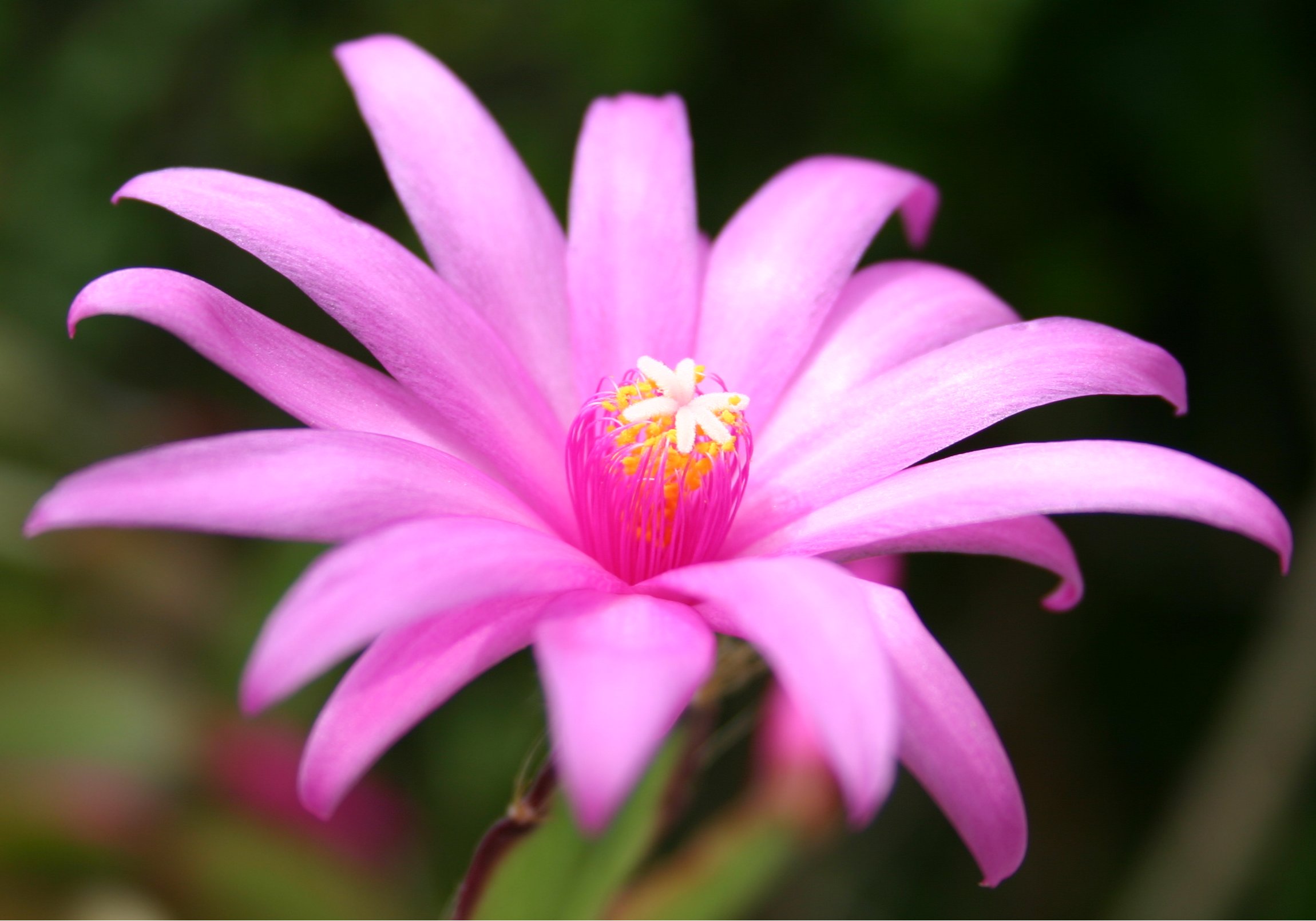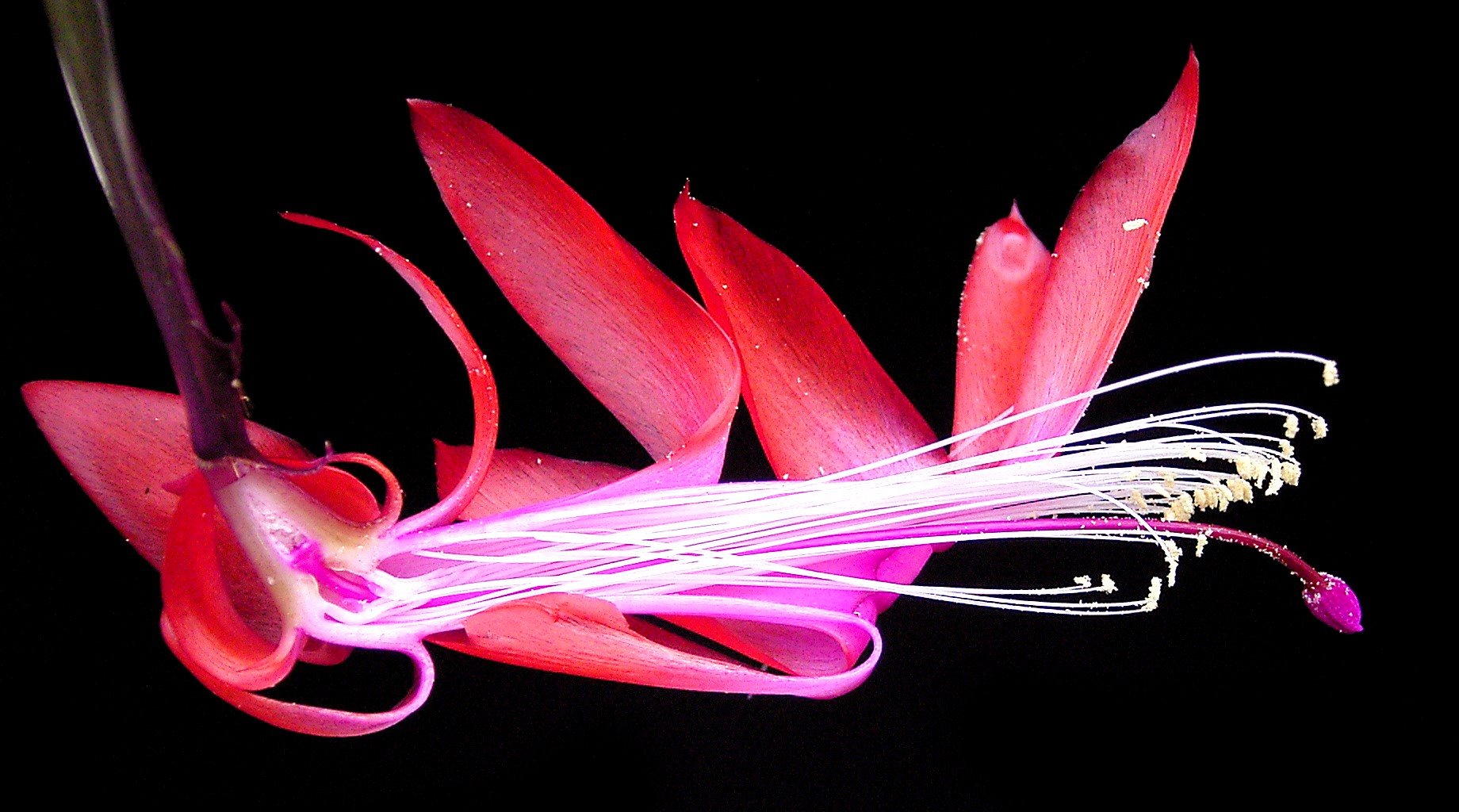|
Schlumbergera × Graeseri
''Rhipsalidopsis gaertneri'', Synonym (taxonomy), synonyms ''Schlumbergera gaertneri'' and ''Hatiora gaertneri'', is a species of epiphyte, epiphytic cactus which belongs to the tribe Rhipsalideae within the subfamily Cactoideae of the Cactus, Cactaceae. Together with the hybrid with ''Rhipsalidopsis rosea, R. rosea'', ''Rhipsalidopsis'' × ''graeseri'', it is known, in English speaking countries in the Northern Hemisphere, as Easter cactus or Whitsun cactus and is a widely cultivated ornamental plant. It has received the Royal Horticultural Society's Award of Garden Merit. Description ''Rhipsalidopsis gaertneri'' is found in southeastern Brazil, in Paraná and Santa Catarina, at altitudes of . ''R. gaertneri'' grows on trees (epiphyte, epiphytic) or less often rocks (lithophyte, lithophytic) in sub-tropical rain forest. With maturity, it develops into a branching pendant leafless shrub with a woody base. The stems are made up of segments, most of which are flattened an ... [...More Info...] [...Related Items...] OR: [Wikipedia] [Google] [Baidu] |
Synonym (taxonomy)
The Botanical and Zoological Codes of nomenclature treat the concept of synonymy differently. * In botanical nomenclature, a synonym is a scientific name that applies to a taxon that (now) goes by a different scientific name. For example, Linnaeus was the first to give a scientific name (under the currently used system of scientific nomenclature) to the Norway spruce, which he called ''Pinus abies''. This name is no longer in use, so it is now a synonym of the current scientific name, '' Picea abies''. * In zoology, moving a species from one genus to another results in a different binomen, but the name is considered an alternative combination rather than a synonym. The concept of synonymy in zoology is reserved for two names at the same rank that refers to a taxon at that rank - for example, the name ''Papilio prorsa'' Linnaeus, 1758 is a junior synonym of ''Papilio levana'' Linnaeus, 1758, being names for different seasonal forms of the species now referred to as ''Araschnia ... [...More Info...] [...Related Items...] OR: [Wikipedia] [Google] [Baidu] |
Blumenau
Blumenau is a city in Vale do Itajaí, state of Santa Catarina (Brazil), Santa Catarina, in the South Region, Brazil, South Region of Brazil. It is away from the state capital of Florianópolis. The city was founded by the German chemist and pharmacist Hermann Blumenau, Hermann Bruno Otto Blumenau (1819–1899), who arrived on a boat via Itajaí-Açu River accompanied by seventeen other Germans. It has a cultural agenda focused on parties based on the daily life and habits of European immigrants, with emphasis on German heritage, including the second largest Oktoberfest in the world, which takes place during 17 days in October. History The city was founded September 2, 1850, by Hermann Blumenau, Hermann Bruno Otto Blumenau and seventeen other German Brazilian, German immigrants. Later arrivals include biologist and early proponent of Darwinian Evolution, Fritz Müller. The history of Blumenau is the result of the arrival of German immigrants who settled these fertile are ... [...More Info...] [...Related Items...] OR: [Wikipedia] [Google] [Baidu] |
Cultivar
A cultivar is a type of cultivated plant that people have selected for desired traits and when propagated retain those traits. Methods used to propagate cultivars include: division, root and stem cuttings, offsets, grafting, tissue culture, or carefully controlled seed production. Most cultivars arise from purposeful human manipulation, but some originate from wild plants that have distinctive characteristics. Cultivar names are chosen according to rules of the International Code of Nomenclature for Cultivated Plants (ICNCP), and not all cultivated plants qualify as cultivars. Horticulturists generally believe the word ''cultivar''''Cultivar'' () has two meanings, as explained in '' Formal definition'': it is a classification category and a taxonomic unit within the category. When referring to a taxon, the word does not apply to an individual plant but to all plants that share the unique characteristics that define the cultivar. was coined as a term meaning "cultivated var ... [...More Info...] [...Related Items...] OR: [Wikipedia] [Google] [Baidu] |
Northern Hemisphere
The Northern Hemisphere is the half of Earth that is north of the Equator. For other planets in the Solar System, north is defined as being in the same celestial hemisphere relative to the invariable plane of the solar system as Earth's North Pole. Owing to Earth's axial tilt of 23.439281°, winter in the Northern Hemisphere lasts from the December solstice (typically December 21 UTC) to the March equinox (typically March 20 UTC), while summer lasts from the June solstice through to the September equinox (typically on 23 September UTC). The dates vary each year due to the difference between the calendar year and the astronomical year. Within the Northern Hemisphere, oceanic currents can change the weather patterns that affect many factors within the north coast. Such events include El Niño–Southern Oscillation. Trade winds blow from east to west just above the equator. The winds pull surface water with them, creating currents, which flow westward due to the Corio ... [...More Info...] [...Related Items...] OR: [Wikipedia] [Google] [Baidu] |
Hatiora ×graeseri Flower
''Hatiora'' is a small genus of epiphytic cacti which belongs to the tribe Rhipsalideae within the subfamily Cactoideae of the Cactaceae. Recent taxonomic studies have led to the three species formerly placed in subgenus ''Rhipsalidopsis'' being removed from the genus, including the well known and widely cultivated ornamental plants known as Easter cactus or Whitsun cactus (cultivars or hybrids of the former '' Hatiora gaertneri''). Description All ''Hatiora'' species are found as epiphytes growing on trees or (rarely) lithophytes growing on rocks. They are found in the tropical rainforests of the Mata Atlântica in eastern Brazil. The plants are weakly succulent, growing more or less upright and becoming woody at the base when older. Spines are usually missing. The insect-pollinated flowers are borne terminally. They are small, with a diameter of about , actinomorphic (radially symmetrical), bell-shaped and always coloured (yellow, yellow-orange or pink). The fruit is a ber ... [...More Info...] [...Related Items...] OR: [Wikipedia] [Google] [Baidu] |
Molecular Phylogenetics
Molecular phylogenetics () is the branch of phylogeny that analyzes genetic, hereditary molecular differences, predominantly in DNA sequences, to gain information on an organism's evolutionary relationships. From these analyses, it is possible to determine the processes by which diversity among species has been achieved. The result of a molecular phylogenetic analysis is expressed in a phylogenetic tree. Molecular phylogenetics is one aspect of molecular systematics, a broader term that also includes the use of molecular data in taxonomy and biogeography. Molecular phylogenetics and molecular evolution correlate. Molecular evolution is the process of selective changes (mutations) at a molecular level (genes, proteins, etc.) throughout various branches in the tree of life (evolution). Molecular phylogenetics makes inferences of the evolutionary relationships that arise due to molecular evolution and results in the construction of a phylogenetic tree. History The theoretical f ... [...More Info...] [...Related Items...] OR: [Wikipedia] [Google] [Baidu] |
Wilhelm A , the Dutch national anthem
{{Disambiguation ...
Wilhelm may refer to: People and fictional characters * William Charles John Pitcher, costume designer known professionally as "Wilhelm" * Wilhelm (name), a list of people and fictional characters with the given name or surname Other uses * Mount Wilhelm, the highest mountain in Papua New Guinea * Wilhelm Archipelago, Antarctica * Wilhelm (crater), a lunar crater See also * Wilhelm scream, a stock sound effect * SS ''Kaiser Wilhelm II'', or USS ''Agamemnon'', a German steam ship * Wilhelmus "Wilhelmus van Nassouwe", usually known just as "Wilhelmus" ( nl, Het Wilhelmus, italic=no; ; English translation: "The William"), is the national anthem of both the Netherlands and the Kingdom of the Netherlands. It dates back to at least 1572 ... [...More Info...] [...Related Items...] OR: [Wikipedia] [Google] [Baidu] |
Karl Hermann Leonhard Lindinger
Karl may refer to: People * Karl (given name), including a list of people and characters with the name * Karl der Große, commonly known in English as Charlemagne * Karl Marx, German philosopher and political writer * Karl of Austria, last Austrian Emperor * Karl (footballer) (born 1993), Karl Cachoeira Della Vedova Júnior, Brazilian footballer In myth * Karl (mythology), in Norse mythology, a son of Rig and considered the progenitor of peasants (churl) * ''Karl'', giant in Icelandic myth, associated with Drangey island Vehicles * Opel Karl, a car * ST ''Karl'', Swedish tugboat requisitioned during the Second World War as ST ''Empire Henchman'' Other uses * Karl, Germany, municipality in Rhineland-Palatinate, Germany * ''Karl-Gerät'', AKA Mörser Karl, 600mm German mortar used in the Second World War * KARL project, an open source knowledge management system * Korean Amateur Radio League, a national non-profit organization for amateur radio enthusiasts in South Korea * KAR ... [...More Info...] [...Related Items...] OR: [Wikipedia] [Google] [Baidu] |
Alwin Berger
Alwin Berger (28 August 1871 – 20 April 1931) was a German botanist best known for his contribution to the nomenclature of succulent plants, particularly agaves and cacti. Born in Germany he worked at the botanical gardens in Dresden and Frankfurt. From 1897 to 1914 he was curator of the Giardini Botanici Hanbury, the botanical gardens of Sir Thomas Hanbury at La Mortola, near Ventimiglia in northwestern Italy, close to the border with France. After working in Germany from 1914 to 1919, Berger studied in the United States for three years, before spending his final years as director of the department of botany of the natural history museum in Stuttgart His main work, ''Die Agaven'', published in 1915, described 274 species of agave, divided into 3 subgenera, ''Littaea'', '' Euagave'' and ''Manfreda''. He also recognised a new genus of cactus, ''Roseocactus'', in 1925. The genera ''Bergerocactus'' (''Cactaceae'') and ''Bergeranthus'' (''Mesembryanthemaceae'') are named in ... [...More Info...] [...Related Items...] OR: [Wikipedia] [Google] [Baidu] |
Friedrich Karl Johann Vaupel
Friedrich Karl Johann Vaupel ( 23 May 1876, Kreuznach – 4 May 1927, Berlin) was a German botanist who specialized in the study of cacti. He was the binomial authority of many species within the family Cactaceae. He studied medicine and natural sciences in Berlin, Heidelberg and Munich, obtaining his PhD in 1903 as a student of Karl Ritter von Goebel at Munich. While still a student, he participated in a scientific journey to Mexico and the West Indies (1899–1900). Following graduation, from 1903 to 1907, he was involved in an extended expedition to India, Australia and Samoa.Biodiversity Heritage Library Taxonomic literature : a selective guide to botanical publications In 1908 he began work as an assistant at the [...More Info...] [...Related Items...] OR: [Wikipedia] [Google] [Baidu] |
Schlumbergera
''Schlumbergera'' is a small genus of cacti with six to nine species found in the coastal mountains of south-eastern Brazil. These plants grow on trees or rocks in habitats that are generally shady with high humidity, and can be quite different in appearance from their desert-dwelling cousins. Most species of ''Schlumbergera'' have stems which resemble leaf-like pads joined one to the other and flowers which appear from areoles at the joints and tips of the stems. Two species have cylindrical stems more similar to other cacti. Recent phylogenetic studies using DNA have led to three species of the related genus '' Hatiora'' being transferred into ''Schlumbergera,'' though this change is not universally accepted. Common names for these cacti generally refer to their flowering season. In the Northern Hemisphere, they are called Christmas cactus, Thanksgiving cactus, crab cactus and holiday cactus. In Brazil, the genus is referred to as (May flower), reflecting the period in whi ... [...More Info...] [...Related Items...] OR: [Wikipedia] [Google] [Baidu] |


.jpg)

